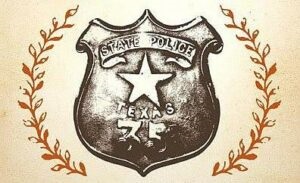After the Civil War and during Reconstruction, Texas was lawless and chaotic. Between 1865 and 1868, a recorded 939 murders had been committed. The need for a statewide organization like the Texas Rangers became evident.
 The Police Act of July 1870 authorized a force reaching 200 members. The State Police were authorized to arrest offenders when local law officers failed to do so. Adjutant General James Davidson was appointed Chief of the State Police although he was paid no more than his men. The police came from all walks of life: They were Black, Hispanic and White, and had fought as both Union and Confederate soldiers. Some were excellent lawmen, some were criminals.
The Police Act of July 1870 authorized a force reaching 200 members. The State Police were authorized to arrest offenders when local law officers failed to do so. Adjutant General James Davidson was appointed Chief of the State Police although he was paid no more than his men. The police came from all walks of life: They were Black, Hispanic and White, and had fought as both Union and Confederate soldiers. Some were excellent lawmen, some were criminals.
Remarkably in the first two years by 1872, the multi-racial force made 6,820 arrests—including 587 for murder, 760 for attempted murder, and 1,748 for other felonies. The value of recovered stolen property was $200,000 (equivalent of $4.5 million today).
Despite the success of the State Police, the fact that the force employed Blacks and was commanded by controversial Governor Edmund J. Davis, a Texan who fought as a Union General during the Civil War, made it unpopular. Some older studies describe the State Police as politically oriented and corrupt, but available evidence does not substantiate this conclusion.
On April 22, 1873 the State Police were reconstituted into Texas Ranger units: the Frontier Battalion on the Border and the Special Force. Led by former State policeman Leander H. McNelly, the new Ranger Company included at least thirty-six other State Police members. Blacks did not serve in the ranks of the Frontier Battalion or the Special Force as they did the State Police.
They did remain active in Texas Ranger companies as teamsters and chuckwagon cooks, taking up arms in fights and gaining respect, like Teamster Jim Werner of Company B, to be pictured in Company group photos.